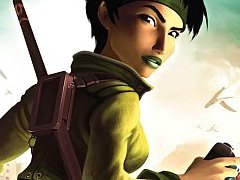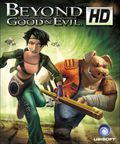You can trust VideoGamer. Our team of gaming experts spend hours testing and reviewing the latest games, to ensure you're reading the most comprehensive guide possible. Rest assured, all imagery and advice is unique and original. Check out how we test and review games here
Find yourself a blender. Grab a copy of Ocarina of Time, Mario 64 and Metal Gear Solid and throw them in, making sure to close the lid firmly. Turn that sucker on. Watch with beady-eyed fascination as the three games spin furiously about the container, their mechanics swishing round and round, gradually becoming one with each other. Give it a minute or two, then kill the power. Despite being born of multiple ideas and features, there’s enough charm and character in the resulting concoction to call it new.
This metaphorical recipe for Beyond Good and Evil is somewhat out of date now. Eight long years have passed since Michel Ancel first brought his action adventure into the world, and game design moves at a fantastic rate of knots. Fear not, though, as a pinch of HD seasoning thrown into the original mix make this the perfect opportunity for a belated second helping.
The events of the game unfold on the small mining planet of Hillys, a futuristic wonderland of strange technologies, rustic architecture and flourishing wildlife. Everything about this world is a contradiction, but a distinct visual style and unique atmosphere manage to tie it all together surprisingly well. The denizens of this planet are anthropomorphic oddities: bipedal chickens, sharks and walruses, all living happily alongside your bog-standard homo-sapiens. The game’s protagonist, Jade, is of the latter category; a young reporter with short, messy hair and a huge pair of green lips. Despite this, she’s actually rather attractive – even more so in high-definition with the extra polys of a re-worked character model.
Tasked with investigating the Alpha Sections – a military dictatorship that’s supposedly protecting Hillys from alien attacks – Jade uncovers the distressing truths that spur the game’s plot. It transpires that the aliens, DomZ as they’re known, are actually in cahoots with the Alpha Sections. With the help of a small group of rebels, it’s your job to expose their true intentions. Trotting along behind you on this journalistic jaunt is Pey’J, your human-pig hybrid of an uncle and source of much of the game’s charm. “Thanks Jade!” he might shout with a slight Texan twang. “If you hadn’t saved me, I’d be smoked ham by now!” The pig jokes fly thick and fast over the course of the 12 hour adventure, but they rarely get old.
Each of the four main investigations (or ‘dungeons’, if you prefer more traditional Zelda lingo) is found by traversing the hubworld of Hillys – a series of islands dotted about a vast blue pond. To get from A to B you’ll need to jump in your trusty hovercraft, which can be docked at certain key areas. In addition to combat and stealth-heavy plot missions, Hillys offers a wealth of other ways to pass your time. You could choose to chase enemy looters through cramped networks of caves, take some time off to hit the bars of the Pedestrian District, or enter your hovercraft in a series of races. Each of these activities rewards Jade with a pearl, a shiny spherical substitute for Mario’s stars.
Refreshingly, Jade’s job as a photojournalist does more than drive the plot. Your objective in each mission is to collect evidence of Alpha Section’s lies and send it back to HQ as evidence. Jade’s camera – accessible with a quick tap of LB – also has a secondary purpose to catalogue every animal that populates the planet. This isn’t as straightforward as it might initially seem. Some creatures need to be coaxed out of their hiding place with specific actions or items, whilst others – like the whales that occasionally leap out of the blue depths of the hub world – require precise aiming and quick reactions to snap before they disappear back into their habitats.
The final hours of the game are particularly memorable, with the detonation of several narrative bombs and a final boss battle with an unusual twist. While characterisation in games has come a long way since 2003, it’s clear to see why Beyond Good and Evil was released to such a rowdy round of applause the first time round. The dialogue is entertaining and well-written, with neatly defined characters advancing a hard-to-predict story.
Beyond Good and Evil was ahead of its time in many respects, but eight years on and those niggling flaws you were happy to let slide have become sizeable problems. Most of my frustrations stem from the camera, which darts and zooms about an environment with a complete disregard for what you actually need to see. It’s simply too close to your character, and although you can rotate it with the right-stick, it rarely behaves as you’d expect, especially during combat sections. The lack of a mini-map while exploring the hub-world is a trifle annoying too, forcing you to go in and out of the menu screens every few minutes to work out where you are.
For all its charm and character, this isn’t a game that has aged fantastically well. The new character models and HD visuals do a great job of bringing Hillys to life, but only serve to contrast how far game design has come in eight years. We’re more critical of camera issues and interface problems these days, spoiled by the likes of Uncharted and Mass Effect. Considering the effort gone into revamping the character models, it strikes me as odd that Ubisoft hasn’t addressed these issues too. For a measly 800 points, however, you’re getting one of the best action adventure games of its day. Sure, under the new paint is some slightly rotten woodwork, but it’s built on an incredibly solid foundation. If you passed on the opportunity the first time round, now is a great time to find out what you missed.
Beyond Good & Evil
- Platform(s): GameCube, PC, PlayStation 2, PlayStation 3, Xbox, Xbox 360
- Genre(s): Adventure







